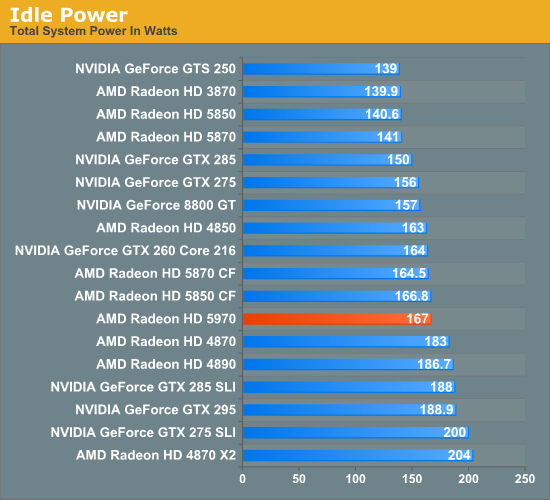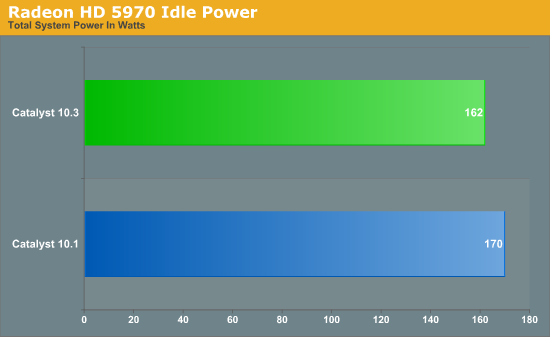What's New: AMD's Catalyst 10.2 & 10.3 Drivers
by Ryan Smith on February 16, 2010 12:00 AM EST- Posted in
- GPUs
10.2: Ultra Low Power State Confusion & Crossfire Eyefinity
When AMD was first briefing us on the 10.2 drivers, one of the first things they discussed was Ultra Low Power State (ULPS) support – this was probably a mistake. In our initial Radeon HD 5870 article covering the whole Evergreen architecture we discussed ULPS, albeit not under that name. ULPS was one of the many features AMD had briefed us about in September when they introduced the 5000 series, where ULPS allows AMD to power down the slave card(s) in a Crossfire configuration to a state even lower than idle. For the 5870/5970, this meant being able to reduce the slave(s) from 27W at idle to 20W under ULPS. This is only a 7W difference, but combined with other idle-efficient hardware it can become a notable difference. At the time it had been our understanding that this feature was enabled right out of the gate.
So imagine our confusion when at CES AMD is telling us that they are just enabling that feature for the entire 5000 series. Until that moment as far as we knew this feature was already enabled.
This started an almost immediate chain of confusion between ourselves and AMD. Terry Makedon – AMD’s Manager of Software Product Management – was giving the presentation and found himself at the end of an odd stare from us rather quickly. When we asked for clarification on this, he said that this feature was just finally going to be enabled in the mainstream Catalyst drivers, and that previously it had only been enabled for the 5970 in the launch drivers for that card. After expressing our displeasure on the issue, we quickly moved on due to time constraints.

The Radeon HD 5970: The card ULPS was practically made for
This brings us to February, where we started work on this article after wrapping up the Radeon HTPC investigation last week. Seeking further clarification on the issue and to once again express our displeasure with how this was handled, we sent an email to our favorite PR contact over at AMD, Evan Groenke. Evan has only been AMD’s PR frontman for hardware editors since the start of the year, and he’s been the guy largely responsible for helping us nail down all the issues we were seeing with the new Radeon 5000 series cards in HTPC use.
After sending that email early Friday morning, we got a phone call from Evan later that day… from the ski slopes. What was supposed to be a long weekend for him turned out to be a bit of a working weekend as he did what he could to dig in to the issue and to find a better explanation for us. Thanks to him we have a solid explanation on what’s going on and why our earlier tests were not as compromised as we once thought they were.
The key issue for AMD is that they did not consider the software side of ULPS to be ready for public use when the 5000 series launched, so it was not enabled in the Catalyst drivers at the time. ULPS was then enabled for the 5970 launch, where AMD was confident it was going to work correctly under the very limited conditions encountered by a single-card dual-GPU setup. But this was only enabled for the launch driver for the 5970 – it was never enabled in the mainline Catalyst drivers.
The issue for us, and why we were initially so displeased, was that it had never been communicated to us that ULPS wasn’t enabled from the beginning. We thought that it was enabled, AMD thought we knew that it wasn’t. So when we did our testing of the 5700, 5800, and 5900 series, we based all of our data on the idea that this feature was enabled, when in retrospect it wasn’t. Worse, it was enabled on the drivers we used to test the 5970 but not the 5870/5850, so our results would have the 5970 consuming less power at idle than what a real user would get if they used the mainline Catalyst drivers. This makes the results invalid, and was the source of our concerns.

Our original 5970 results
All of this was finally clarified when Evan was able to tell us two things: that the driver set we used to test the 5970 had been posted as a hotfix driver for the 5970 launch, and that it wasn’t the only driver with ULPS enabled. The former is of particular importance since coming from CES our interpretation had been that ULPS was not enabled on any public driver build, when in fact it just hadn’t been enabled on any mainline driver build – it had in fact been available in public hotfixes such as the 5970 launch driver. The latter is important because it was an undocumented feature of the 9.12 hotfix, which as we explained earlier is the precursor to much of what’s in the 10.2 driver being released today. So if you used the 9.12 hotfix, then you’ve already been enjoying ULPS on your 5000-series Crossfire setups.
With that in mind, here’s what the issue ultimately boils down to: Unless you were using the 5970 launch driver or the 9.12 hotfix, you have not been enjoying the benefit of ULPS. Specifically, unless you have used those drivers your idle power usage on the 5970 would have been around 7W higher than what we found in our initial 5970 review. It’s only now with today’s 10.2 driver that this is finally being enabled for customers using the mainline driver. If that’s you, then the 10.2 drivers should reduce your idle power usage some.
To settle this point, here we have a re-test of the 5970 using the 10.1 Catalyst drivers, and the 10.3 beta drivers AMD has provided us.

Our new 5970 results. Note: This is a different test setup than for our original results
The end result: a difference of 8W, out of 170W, meaning enabling it reduces idle power usage by around 5% on our overclocked Core i7 920 setup.
Moving on from ULPS, we have Crossfire Eyefinity, one of the other features that was previously exposed in the 9.12 hotfix driver. Much like ULPS, this feature was originally only enabled for the 5970 while AMD worked out the kinks in the technology. Since the 5970’s launch this feature has made a great deal of progress – it’s no longer a whitelist feature that only works on certain games, but rather it’s a blacklist feature where AMD only disables it on games where there are known issues.
We strongly suspect that anyone that had a vested interest in a Crossfire Eyefinity setup with a pair of 5800/5700 series cards already is on the 9.12 hotfix, but nevertheless this brings Crossfire Eyefinity in to the mainline drivers for everyone else.










75 Comments
View All Comments
bhaberle - Monday, March 8, 2010 - link
It looks like ATI Catalyst 10.3 Beta leaked out. I am pretty happy with it. You can download it here ( http://www.geekmontage.com/ati-catalyst-10-3-beta-...">http://www.geekmontage.com/ati-catalyst-10-3-beta-... ) I see it on a few other sites too, just do a google search.dvdreplication - Thursday, February 25, 2010 - link
Well dana i have placed my order for it. Hope that it 'll be a very nice product. Thanks for sharing.http://www.easyreplication.co.uk/">http://www.easyreplication.co.uk/
Scali - Monday, February 22, 2010 - link
Is it just me, or did ATi not talk about OpenCL support at all?As far as I can tell, it's still not included in the 10.2 drivers, I still need to install the Stream SDK to get the actual OpenCL runtimes.
This is not acceptable for distribution to end-users. They will just need to include the OpenCL runtimes in the driver package.
DanaGoyette - Saturday, February 20, 2010 - link
Mobility drivers for HD-series graphics cards sounds great... but what about laptops that have the FireGL-branded cards, such as mine?For example, HP's latest Win7 driver for my laptop is 8.632 -- which is really old.
http://h20000.www2.hp.com/bizsupport/TechSupport/S...">http://h20000.www2.hp.com/bizsupport/Te...ng=13&am...
My ideal case: mobility drivers that offer the professional features (such as "10-bit pixel format", though I don't have a display capable of using that) -- even if they're not ISV-certified.
Also, ATI has had some form of quad-buffered stereo on the workstation cards for a while; it's cool to see it now expanded to cover consumer cards (and hopefully laptops, as well).
LordanSS - Friday, February 19, 2010 - link
I had to, one more friggin time, revert back to 9.12 hotfix because the darned mouse cursor bug is back.Why the hell can't they get this straight? Geez.
Quidam67 - Thursday, February 18, 2010 - link
Sorry if this is off-topic, but it seems like a place I might get soem help on this:Having recently returned to AMD with the purchase of a HD5770 I'm having problems with the latest drivers, specifically they just don't seem to (properly) recognise my Panasonic V series LCD. The result is there is no DVI or HDMI (have tried both) Item added to the root tree menu in CCC. This means that amoungst other things, I can't alter the scaling -which by default results in a desktop screen that is significantly shrunk in the middle of my display.
Luckily for me I also own a Samsung LCD. CCC recognises the Samsung and I get the DVI tree menu, which then allows me to adjust the scaling to zero. This setting is "remembered" when I plug back into my Panasonic -but what a headache, and I assume I'll need to do this everytime I update to a new ccc/driverset.
So is this a fault with the Panny and the EDID data it sends, or is this an issue with ATI's software? The ting is I tried a much older rig running a HD3850 AGP and 8.9 drivers, and they seemed to detect the TV fine.
Quidam67 - Friday, February 19, 2010 - link
For what it is worth, the 10.2 drivers seem to have fixed the problem I referred to above. I know get a menu item titled +DVT(DVI)4 in ccc giving me the scaling options back again.Thank god for that. I can only assume that between driver releases 9 thru 10.1 they broke something
Bolas - Thursday, February 18, 2010 - link
Last year I came up with a joke about this subject. Hope you like it.How is ATI like a VW commercial?
They're both "drivers wanted".
Roland00 - Wednesday, February 17, 2010 - link
Does this mean you can use 3 monitors without buying a Displayport monitor and an active adapter? For if you have 4 cards you will have 4 TMDS signal generators.Roland00 - Wednesday, February 17, 2010 - link
Meant to say 2 cards with 4 TMDS signal generators